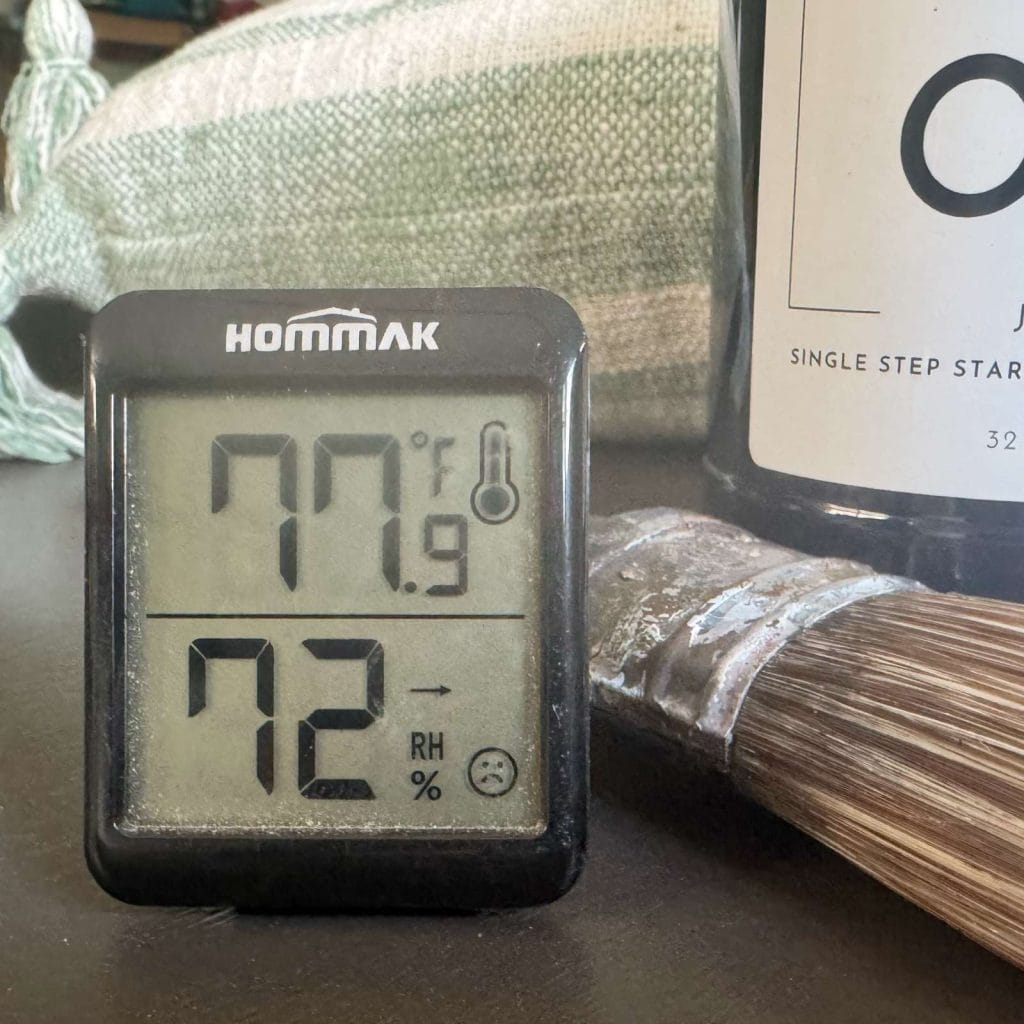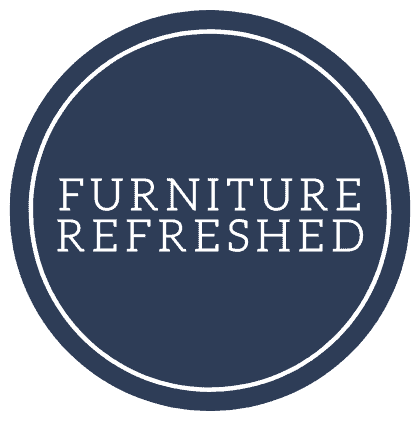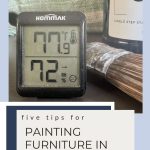Tips for Furniture Painting in Hot Weather

It’s that time of year! I love the summer heat and sunshine, but unfortunately, it’s not always great for painting furniture! Right now we are in the middle of a heat wave and the temperatures are way too high for me to be out working in my garage. But I have been sneaking out early in the morning the past few days to get a little bit accomplished. So I thought I would share some of my tips for painting in hot weather now that summer is officially upon us!
A note on product links
This post contains Amazon affiliate links, meaning I get a small commission on qualifying purchases, at no cost to you.
Why temperature and humidity matter
In addition to your own comfort, painting in hot weather also impacts the paint or topcoat itself. If it is too hot, the paint dries too quickly, and you can get brush strokes, roller marks, or spray lines. If it’s a self-leveling paint, it won’t level properly. High temperatures can chemically affect how your paint bonds to the surface and itself. Painting in direct sunlight can cause bubbling and peeling.
Humidity can also affect dry times. If you live in a very dry climate with low humidity, your paint will likely dry faster than you’d like, and you’ll have the same issues with brush strokes and self-leveling. If it is too humid, your paint or topcoat will dry too slowly, trapping moisture in the finish that can cause cloudiness or streaking.
I have an inexpensive thermometer in my workspace that measures both temperature and humidity, and if either goes above 80, I’m out!
Ideal painting conditions
While 70 degrees and 50% humidity is ideal, most paint brands recommend staying in the range of 50 to 80 degrees and 40% to 80% humidity.
Would you like to save this?
Tip 1: Extend the paint’s work time
Paint dries fast in warm temperatures and/or low humidity. Even if you are still within the “safe” temperature/humidity for a product, it still may be drying faster than you’d like! To increase your work time, add a bit of water (for water-based products) or an extender to your paints and top coats. The type of extender depends on the product. I use water-based products almost exclusively, so my recommendations are for those. Generally, I’ll add a bit of water to my paint and General Finishes Extender to my top coat. Floetrol is another great option for a paint extender.
Tip 2: Use a misting bottle
As an alternative to adding water directly to your paint, you can also mist the surface you are painting with a misting bottle. This will help with give you a brush-stroke free finish. I almost always have a misting bottle on hand in the summer months use it when applying my paint. I don’t like to mist for my topcoat, I find it can cloud up the finish and also affect the durability.
Tip 3: Paint early or late in the day
As I mentioned before, keeping an eye on the temperature and humidity is important. Working in the early morning or later in the day will hopefully give you some time in these safe zones, even on a really hot day. I’ll often go out first thing in the morning and paint until temps start climbing.
Tip 4: Work on prep and repairs
If you can brave the heat and want to get some work done, focus on tasks that aren’t affected by temperature, like cleaning, sanding, and repair work. You’ll be plenty hot, but at least you’ll be able to get something done! It’s all about batching your work. I’ll often get my paint and or topcoat on early in the morning, then switch to other tasks when it starts getting hot, do those for as long as I can stand it! And if this is a business and you don’t want to lose too much productivity on a hot day, it’s also a great time to catch up on some of the less fun business stuff, photo editing, furniture listings, or ordering supplies.
Tip 5: Bring it inside!
If you have the space (and air conditioning) inside, bring your projects in and work on them there. Smaller projects like end tables or nightstands are easy to move around and can be painted indoors relatively easily. If you are in the furniture painting business or want to do a lot of painting, consider using an air conditioner in your workspace (such as a shed or garage).
Summary
Painting in hot weather definitely comes with its challenges, but with a little planning and a few adjustments, you can still get great results. Whether you’re adjusting your schedule, adding extenders to your products, or working inside during a heat wave, these small shifts can help protect your finish. Stay cool out there, and let me know if you have any go-to tips for painting furniture during the summer months!



